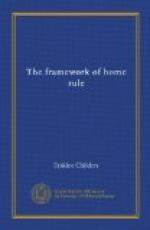decisive with Durham. At the last moment he gave
way to a dread of predominant French influence in
Lower Canada, similar at bottom to his dread of the
unchecked influence of the British minority. While
he feared that the latter, if let alone, would inaugurate
a reign of terror, he added also: “Never
again will the present generation of French-Canadians
yield a loyal submission to a British Government.”
The argument is inconsistent with the whole spirit
of the Report, which attributes the friction in both
Provinces to bad political institutions. It is
probable that Durham was really more influenced by
the quite reasonable recognition that the French were
relatively backward in civilization and ideas.
He sought, therefore, both to disarm them politically
and to anglicize them socially, by amalgamating their
political system with that of wholly British Upper
Canada. His calculation was that in a joint assembly
the British would have a small but sufficient majority.
The estimated population of Lower Canada was 550,000,
of whom 450,000 were French, and 100,000 British and
Irish; that of Upper Canada 400,000, all British and
Irish. That is to say, that in both Provinces
together there was a British and Irish majority of
100,000. The calculation over-estimated the British
element, but in the event this mistake proved to be
immaterial. Though Durham himself appears to have
intended representation to be in strict accordance
with population, the Union Act, passed in 1840, allotted
an equal number of representatives in the Joint Assembly
to each of the old Provinces. The assumption here
was that the British Members from Upper Canada would
unite with those of old Lower Canada to vote down
the French, just as the Ulster Protestants voted with
English members to vote down the Irish majority.
In practice the Union, after lasting twenty-six years,
eventually broke down. Durham’s fear of
French disloyalty proved to be as groundless as his
ideal of complete anglicization was futile. It
was neither necessary, sensible, nor possible to extinguish
French sentiment, and human nature triumphed over
this half-hearted effort to apply in dilution the
medicine of Fitzgibbonism to the Colonies. Little
harm was done, because the introduction of responsible
government, far transcending the Union in importance,
worked irresistibly for good. Parties did not
run wholly on racial lines, but racialism was encouraged
by the equal representation of the two Provinces in
the Assembly, in spite of the greater growth of population
in the Upper Province. The system was unhealthy,
and at last produced a state of deadlock, in which
two exactly equal parties were balanced, and a stable
Government impossible. When that point was reached,
men began to observe the strong and supple Constitution
of the adjacent United States, and to recognize that
a politically feeble Canada was courting an absorption
from that quarter which all Canadians disliked.
The Legislative Union was dissolved by the mutual




